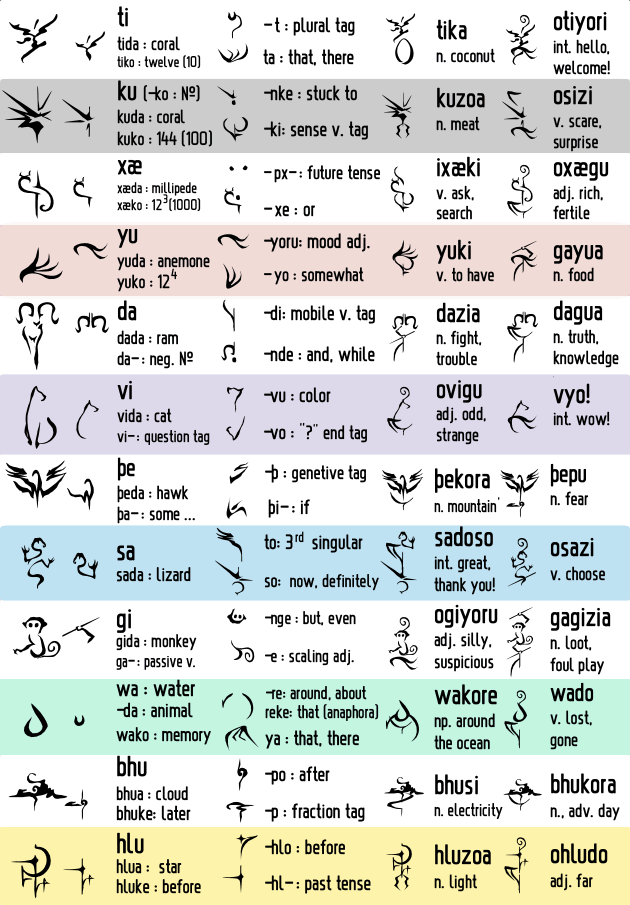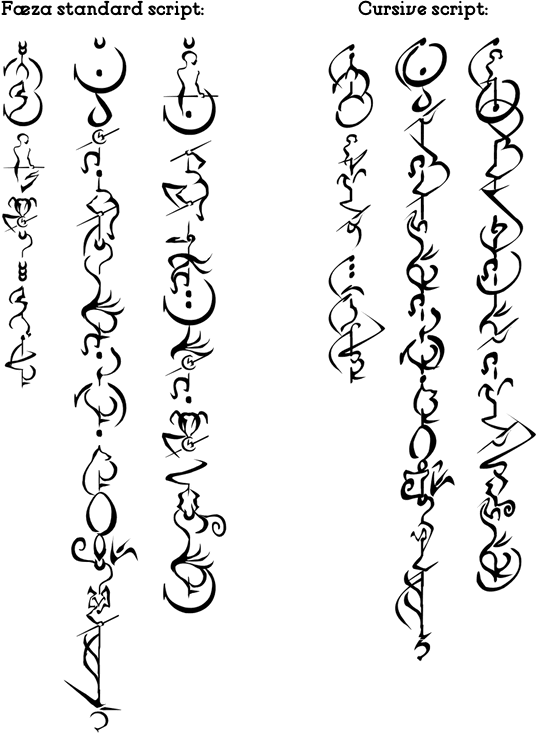
Nalozeþ fæza (or simply Fæza) script was invented by Max Greiner while idly gazing at various ocean debris on a quiet beach in Matemwe, Zanzibar in 2020. It is closely associated with the co-constructed language Naloze (or Nalozeþ garuzia). Fæza is a semi-pictographic syllabary which derives abstract pictomorphs from twenty four core pictograms to construct a larger set of semantic allomorphs, in a manner not unlike Japanese hiragana. These are then combined under a finite set of phonotactic guidelines to create compound words and a minimalist agglutinative grammar inspired by Kiswahili as well as Samuel Delaney’s hypothetical conlang Babel 17. Nalozeþ’ phonetics also draw inspiration from Kiswahili as well as Kalenjin, and Arabic, most notably in its use of palatal implosives [ç] and [ʝ] and syllabic [n̩] and [m̩] before certain voiced strops.
Nalozeþ’ inspiration came from the various types of symmetry observed in the incredibly diverse beach fauna, and the intricate daily routine of local children catching, trading, and prepping various reef mollusks and crustaceans. The aim was to create an intuitive and charming language based on similar observations of animal life and the natural world (loosely that of a parallel universe’ East Africa, where elephants are a bit larger and ants are even more advanced.) Fæza pictograms are meant to mnemonically evoke the animals and natural elements of Naloze while being relatively easy to write.


The chart above the twenty four core pictograms are displayed along with both their simplified forms (only a shade off in sound and meaning) and pictomorphs (derived images with more loosely related meanings and pronunciations to the core pictograms).
Note from the sample vocabulary that core pictograms and their simplified counterparts are in most cases fairly interchangeable. Technically, the core pictographs are used in compounds referring to what they portray literally, while the simplified forms are used in more figurative contexts (i.e. "nose" /nusi/ is a compound "elephant + snake"; the elephant gram /nu/ is written in its core form, and the snake gram /si/ is written simplified to indicate that it refers to ~"the snaky bit“ of the literal elephant). Usually, the more literal component of a two-syllable compound occurs first. When a variant pronunciation occurs in a second syllable of a compound (such as the /-f/ “-type of appendage” in /çuf/ “right hand”, it is always demarcated by using the simplified form of the gram.
The pictomorphs, however (in the lower left box for each of the twenty four pictorgrams), are distinct from the core and simplified pictograms both semantically and phonemically. Note from the diagram that these pictomorphs, while abstractly related to their core grams, handle basically all of Nalozeþ’ closed-set features, such as cases, classes, modes, tense, and allomorphic features such as gerunds. They almost always reserve separate pronunciations than any of the core grams, and are typically agglutinative (a preceding or follow / - / typically indicates how these phonemes connect to core grams to adjust their meaning, part of speech, or both). For example, the ~legs part of the “ram / goat” symbol /da/ is used to write the syllable /-di/, a suffix that transforms the core syllable into a locomotive verb. /imædi/ “to walk” has the core /mæ/ “human,” whereas /ibadi/ “to swim” uses the core syllable /ba/ meaning “fish” (see diagram 2 for more breakdowns of affixes along with common examples).

Mænlo ganujai bhuyorindi lon yumpande zujam sizet yukiloze. Lon wayampande nuziat yukindi mrekeviki feþi kalit huziadidiso.
(Rense ariloze mæþzujampat aribia sike)
All human beings are born free and equal in dignity and rights. They are endowed with reason and conscience and should act towards one another in a spirit of brotherhood.
(Article 1 of the Universal Declaration of Human Rights)
Also by Max Greiner: Yufrabiz
Constructed scripts for: Ainu | Arabic | Chinese languages | Dutch | English | Hawaiian | Hungarian | Japanese | Korean | Lingala | Malay & Indonesian | Persian | Tagalog / Filipino | Russian | Sanskrit | Spanish | Taino | Turkish | Vietnamese | Welsh | Other natural languages | Colour-based scripts | Tactile scripts | Phonetic/universal scripts | Constructed scripts for constructed languages | Adaptations of existing alphabets | Fictional alphabets | Magical alphabets | A-Z index | How to submit a constructed script
[top]
You can support this site by Buying Me A Coffee, and if you like what you see on this page, you can use the buttons below to share it with people you know.

If you like this site and find it useful, you can support it by making a donation via PayPal or Patreon, or by contributing in other ways. Omniglot is how I make my living.
Note: all links on this site to Amazon.com, Amazon.co.uk
and Amazon.fr
are affiliate links. This means I earn a commission if you click on any of them and buy something. So by clicking on these links you can help to support this site.
[top]